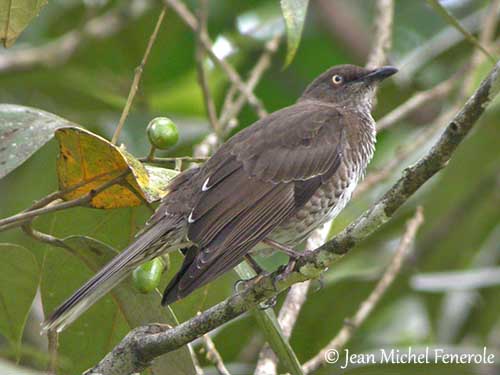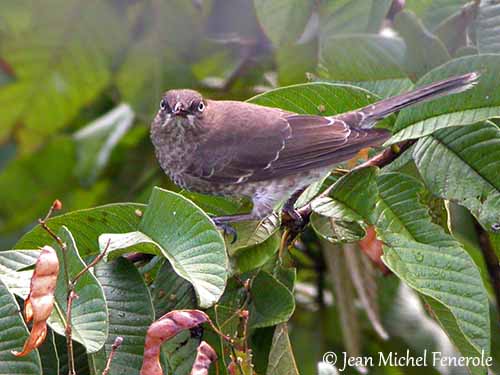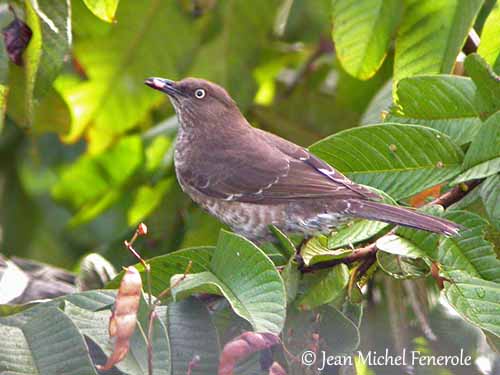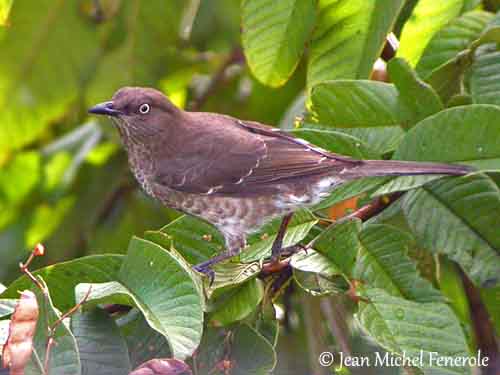
Fr: Moqueur grivotte
All: Schuppenspottdrossel
Esp: Cuitlacoche Oscuro
Ita: Mimo pettoscaglioso
Nd: Geschubde Spotlijster
Sd: Vattrad härmtrast
Photographer:
Jean Michel Fenerole
Photos d’Oiseaux du monde
Text by Nicole Bouglouan
Sources :
HANDBOOK OF THE BIRDS OF THE WORLD Vol 10 by Josep del Hoyo-Andrew Elliott-David Christie - Lynx Edicions - ISBN: 8487334725
WRENS, DIPPERS AND THRASHERS by Brewer David – illustrated by Barry Kent Mackay- Yale University Press - ISBN: 0300090595
BirdLife International (BirdLife International)
Birds & Co – Les Oiseaux de Martinique
Neotropical Birds – Cornell Lab of Ornithology
Scaly-breasted Thrasher
Allenia fusca
Passeriformes Order – Mimidae Family
INTRODUCTION:
The Scaly-breasted Thrasher was formerly placed in the genus Margarops with the Pearly-eyed Thrasher. The genus Margarops has a wide range in the Caribbean.
But following recent molecular evidences, Margarops has been divided into two genera. The Pearly-eyed Thrasher (M. fuscatus) remains in this genus, whereas the Scaly-breasted Thrasher is included now in the genus Allenia of which it is the only member. It is endemic to the Lesser Antilles.
DESCRIPTION OF THE BIRD:
Biometrics:
Length: 23 cm
Wingspan: 27-30 cm
Weight: 67-70 g
The adult of the nominate race has dark grey-brown upperparts and crown. The feathers have darker centres giving a streaked pattern. Lower back and rump are more rufescent. The uppertail-coverts show small white central spots and tips. On the upperwing, the flight-feathers are brownish-black. The tertials show white tips, like the greater wing-coverts which form a pale wingbar. The secondaries are edged rufous on the outer web. The tail is brownish-black too, with white-tipped outer rectrices, conspicuous in flight.
On the underparts, chin and throat are whitish and streaked brown. The streaked pattern becomes more conspicuous on the breast. The belly is white, with dull brown streaks, darker on the sides. The vent is dull greyish-white with brown markings. The underwing-coverts are greyish-brown with darker mottling.
On the head, the crown is dark grey-brown.
The rather short, blackish bill is slightly decurved and reminds that of thrushes of Turdidae family. The eyes are pale yellow. Legs and feet are blackish-brown.

Both sexes are similar.
The juvenile is similar to adults, but with dark eyes.
SUBSPECIES AND RANGE:
We can find five subspecies.
A.f. fuscus (here described) is found on Dominica and Martinique, and disjunctly Grenada.
A.f. atlanticus occurs in Barbados. This one has more reddish-brown upperparts and less white on the tail.
A.f. hypenemus occurs in N Lesser Antilles, from Saba and Barbuda, S to Guadeloupe and Marie-Galante. This race is larger and paler than nominate.
A.f. schwartzi is found on St Lucia. It has more white on the tail than nominate, and longer wings.
A.f. vincenti occurs on St Vincent. This one has darker plumage overall, especially on chin and throat. The flanks show larger and darker spots.
HABITAT:
The Scaly-breasted Thrasher frequents several habitat types such as forest and semi-open woodland, mangroves and dry coastal scrub. It can be found in settled areas too. However, it is more restricted to forest than Margarops fuscatus. The species is visible at all elevations.
CALLS AND SONGS: SOUNDS BY XENO-CANTO
The Scaly-breasted Thrasher’s call is a full “dew-quip”, often uttered while foraging.
The song is typically given in the morning. This is a loud, warbling song, a series of varied notes and phrases.

BEHAVIOUR IN THE WILD:
The Scaly-breasted Thrasher feeds on arthropods, fruits, berries and seeds. This species is largely arboreal and usually forages high in canopy. However, it can be seen lower too, according to the different islands and their vegetation types.
The Scaly-breasted Thrasher is fairly retiring and secretive. Like numerous Mimidae species, it also performs “wing-trembling”, but more rapid and shorter than other species do. They can be quite inconspicuous and often remain in the dense cover and near the ground.
They are territorial and monogamous.
The Scaly-breasted Thrasher is resident in its range. Some vagrants are recorded in Grenadine.
It is distinctive in flight with conspicuous large white terminal spots on outer rectrices. But short distances, sometimes much longer ones, are achieved by running rather than by flying.

REPRODUCTION OF THIS SPECIES:
The breeding season occurs between February and July/August.
The nest is cup-shaped and placed in tree or bush. It is made with sticks and dry twigs, and the inner cup is lined with rootlets and other soft materials.
The female lays 2-3 blue-green, unmarked eggs.
No other available information.
PROTECTION / THREATS / STATUS:
The Scaly-breasted Thrasher has restricted range. It can be common to fairly common in most of N and C Lesser Antilles and on St Vincent. It is rare and local on Grenada.
The race “atlanticus” from Barbados is probably extinct.
The race “hypenemus” could have extended its range.
The Scaly-breasted Thrasher is not currently threatened and described as “common”.
